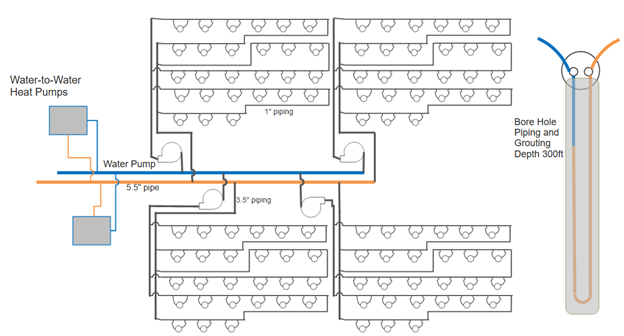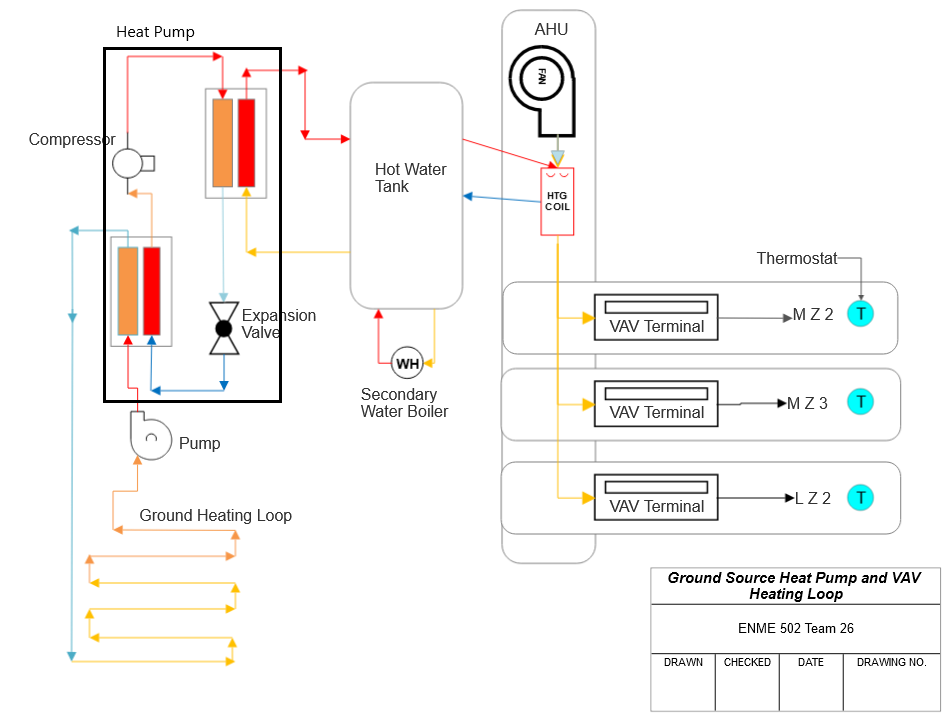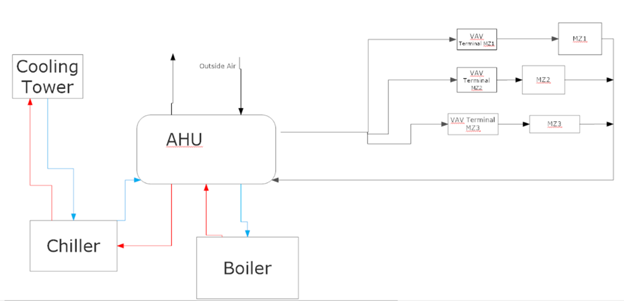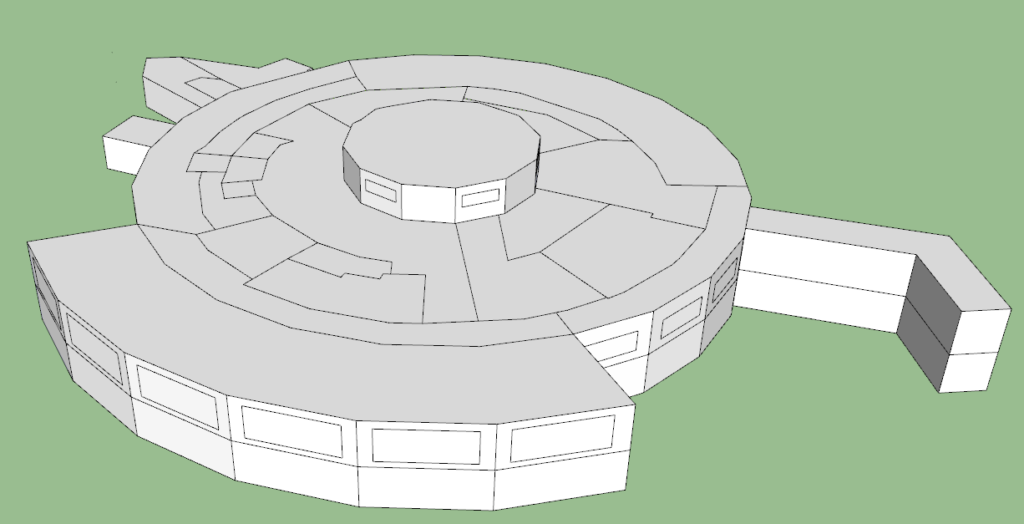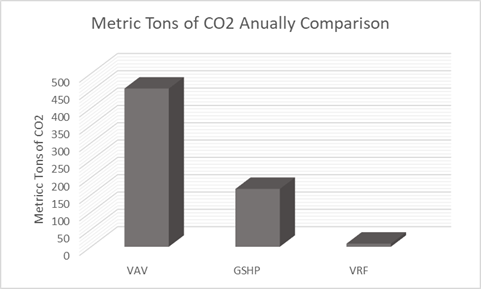Project Category: Mechanical

Join our presentation
About our project
Climate change is a great threat to society and with HVAC systems having a significant impact on the planet, energy efficient heating and cooling systems are becoming more and more important. There are many different solutions to this problem but in this project, we explore a few different versions.
Here we will discuss three different systems, a natural gas boiler and electric chiller, a ground source heat pump (GSHP), and a variable refrigerant flow (VRF) heat pump that could serve the competition building in Prince George. These systems are meant to cover three aspects of current HVAC systems with the GSHP using renewable energy for heating and cooling, the VRF system aiming to be incredibly energy efficient and the natural boiler with electric chiller system representing current industry standard. This project will compare and contrast the three proposed systems and state our final recommendation for ASHRAE.
Meet our team members
Top Left-Adam Klassen: Ground Source Heat Pump & Sketch Up modelling, research

Top Middle- Oliver Cook: VAV system Energy Plus modelling, energy and Environmental Impact study

Top Right-Said Gilmutdinov: VRF system Energy Plus modelling, energy and Life Cycle Cost analysis

Bottom left- Suleman Khan: Project management, SketchUp modelling and Energy+ integration

Bottom middle- Zakaria Yousef: VAV system Energy Plus modelling, building model & External communication

Bottom Right- Jay Kim: VRF system sizing, prices & building model


Details about our design
HOW OUR DESIGN ADDRESSES PRACTICAL ISSUES

How our design addresses practical issues?
This project focuses on designing and comparing three HVAC systems of a new building on a higher education campus in Prince George, British Columbia, Canada with the lowest possible life cycle, maintenance, and utility costs and a budget of $17.5M.
The final HVAC System Selection and Design for the proposed building addresses the following major design goals:
- Energy Use Intensity (EUI) which refers to the total energy used per building area per year(GJ/m^2 in a year). The EUI value we expect to see is around 1 GJ/m^2 in a year. It can be difficult to compare energy use between buildings or systems without a norm or benchmark. Simply calculating the amount of energy used during a given time span ignores the scale, configuration, and form of use of the building. The Energy Use Intensity (EUI) metric will help to level the playing field when comparing different forms of energy use.
- The goal of Life Cycle Cost Analysis (LCCA) is to estimate the total costs of project alternatives and represent that as the capital an owner would need to have immediately to pay for all costs in the systems lifespan of fifty years. This will help us to choose a design that ensures the facility’s overall cost of ownership is within the budget set forth by the owners project requirements while accomplishing our other goals. The LCCA can help decide whether incorporating a high-performance HVAC is cost-effective or not, as it can increase the initial cost but result in significantly lower operational and maintenance costs.
- An environmental impact assessment (EIA) is a method of predicting how a project’s construction will affect the environment. For this project we have measured it as the carbon footprint for each system based off their utilities usage. We can measure the environmental impact of each proposal and choose the one that best meets our needs by assessing the project through the EIA. Since the well-being of nature is critical to preserving global equilibrium, the EIA has gained popularity in assisting in the reduction of greenhouse gas emissions in our project.
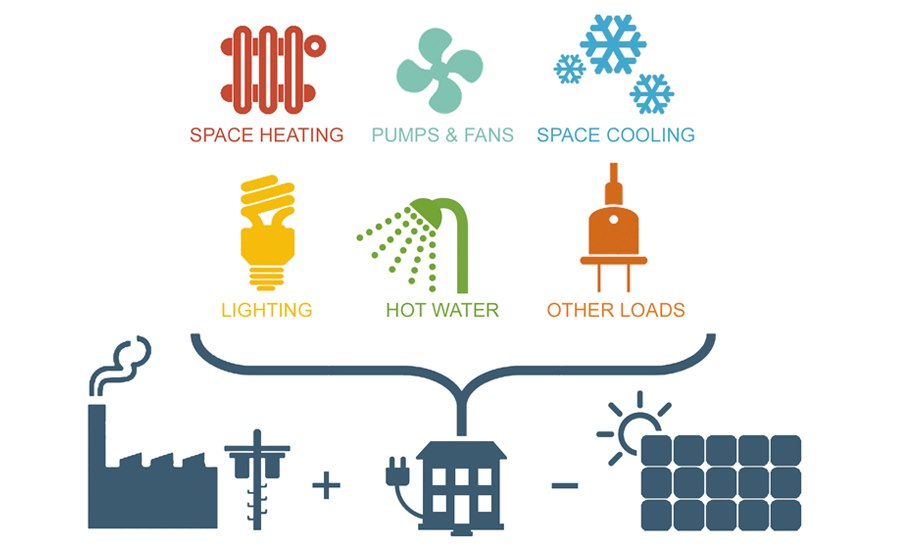
Building Specs
The building in Prince George is a 50,000-square foot cafeteria office hybrid, with 25,000-square feet of office and storage space on the lower level, and 25,000-square feet of cafeteria, kitchen, and dining space on the main level. Rooms in the building include storage, cold storage, mechanical/electrical spaces, kitchens, dining space, cafeteria space, restrooms, office space, and telecommunications spaces. The building will be operational from 7:00 AM to 8:00 PM, seven days a week. Peak occupancy of the building will be 720 students, with an average of approximately 3,000 per day.


WHAT MAKES OUR DESIGN INNOVATIVE
Our team sought innovation in the implementation of newly developing green energy technologies. These being heat pumps both air sourced and ground sourced.
Ground Source Heat Pumps.
GSHP take advantage of renewable geothermal energy to heat or cool a structure. These systems are incredibly efficient capable of generating 4 Joules of energy for every 1 Joule spent. Reaching a 400% return for heating and cooling. The GSHP is also effective in any major settlement in any climate due to the free availability of ground heat energy throughout the world. The major limitation for these heat pump units is the ground piping loop. These loops can take a large area and require planning to develop structures around. It is difficult to install a new GSHP system in an existing structure due to the limitation of the piping loop construction. Another drawback for traditional GSHP systems is due to the limitation of space they are rarely sized large enough to solely provide the entire heating and cooling load for a building. Therefore, most GSHP systems are used with supplementary natural gas boilers and chillers to meat load requirements. Due to this the building will accrue additional costs for the separate distribution systems of the GSHP and natural gas systems. This results in additional installation costs and takes up more usable space in the building.
Our team developed a unique design to achieve excellent green performance and reduce costs by avoiding implementation of separate distribution systems. The GSHP system developed shares the air distribution method of the natural gas system instead of using a separate radiative distribution system as most traditional GSHP systems use. By utilizing high-capacity water-to-water heat pumps the natural gas and GSHP systems can add heat energy to one shared heat reservoir where it can be distributed by one VAV system that is operating with full control of distribution therefore allowing efficient energy use and reducing total space and costs of the system. Our GSHP system was able to reduce utilities CO2 usage by 64% while only accruing an additional 35% in comparative costs to the traditional natural gas chiller and VAV HVAC systems.
Variable Refrigerant Flow system
A VRF system utilizes air sourced heat pumps and high efficiency refrigerants to heat or cool structures. These systems are quite a new technology but they function using the basic principles of a refrigeration cycle to exchange heat between the interior and exterior air. They are highly energy efficient because they don’t need to generate the heating or cooling in the unit, but rather exchange the heat with another source. These systems are powered entirely by electricity, therefore the carbon footprint of these systems is dependent on the source of electricity in the region. For British Columbia and Prince George in Particular all electrical energy is provided through renewable hydro energy. An all-electrical system powered by renewable Hydro electricity can produce the lowest CO2 emissions for operation. The VRF system was able to meet heating and cooling requirements with the smallest CO2 quantity of 9 tons in comparison to GSHP’s 167 tons and a traditional natural gas system’s 457 tons.
WHAT MAKES OUR DESIGN SOLUTION EFFECTIVE
The following 3 systems were designed for our building: Ground Source Heat Pump, Variable air volume as well as the Variable Refrigerant Flow systems for heating and cooling. All systems use VAV Air Handling Units for ventilation. We assessed the systems chosen based on the 3 metrics: costs, energy efficiency and environmental impact.
| Installation Cost (mil CAD) * | Life Cycle Cost (mil CAD) * | Energy Usage Intensity (GJ/m^2) | Environmental impact (Tons CO2) | |
| GSHP | 0.626** | 2.420** | 0.96 | 167 |
| VAV | 1.056 | 1.787 | 1.02 | 456.6 |
| VRF | 1.206 | 3.677 | 0.81 | 9 |
*Note that due to the complexity of designs & complications of work with manufacturers, best available literature sources were used for cost estimation. Thus, it is important to note that these costs do not reflect the complete picture, and further investigation is needed to get a complete picture.
**Due to unavailability of literature data, the drilling costs are not included in the cost estimation of the GSHP system.


VRF, or Variable Refrigerant Flow system was chosen as our final design solution. While VRF is not the most cost-effective system, it is the most energy efficient and most environmentally friendly.
The costs are only best estimates and may be significantly improved with manufacturers collaboration. Therefore, the Life Cycle Cost is not considered to be the deciding factor. Instead, energy efficiency and environmental impact are used to pick the best system.
VRF Heat Pump system is very energy efficient, requiring only 0.81 GJ/m^2 of energy annually. In addition, since it uses electricity only, its environmental impact is also very small when compared to natural gas used in 2 other systems.
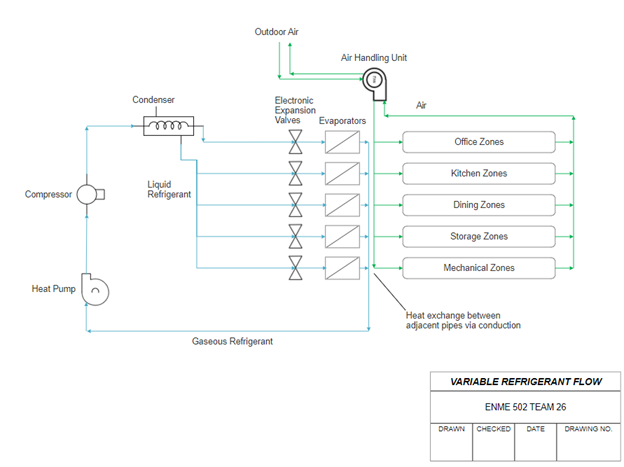
HOW WE VALIDATED OUR DESIGN SOLUTION
Our design solution was mainly validated using a simulation software called Energy Plus which is where all of our results have come from. Energy Plus was used because it was designed by the United States Department of Energy as an open-source software for modelling HVAC systems. The first simulation was for the design heating and cooling loads of the building that we would use to size our equipment. We were able to check these calculations by hand, and the results we saw were very promising. The hand calculations showed a heating load of 533 MJ/hour and the Energy Plus simulation results were 774 MJ/hour. Although there is a sizeable difference between the numbers this is due to simplifying assumptions to make the hand calculations possible. The difference is small enough to say that the software model is reasonably accurate.
During our research for this project, we found that the EUI value for this type of residential building is approximately 1.0 gigajoule of energy used in one year per square meter of building area (GJ/m^2). From our Energy Plus simulations we had values that were all close to that value which gave us more validation that our simulations were accurate.
It is worth mentioning that it is not within our means to perform any physical testing on our computer simulations as it would not be economically or physically feasible. A proper physical simulation would require a scale building with solar loads and people with equipment to represent the interior loads. That is not within our means for this project but we feel that the results from our computer simulations are valid enough to be used.
FEASIBILITY OF OUR DESIGN SOLUTION
The most feasible design is the natural gas boiler and chiller with VAV system. This is because all components of this design are readily accessible. Highly tested proven and reliable and are very cost effective due to the history of development. This system is also incredibly convenient to implement in an existing construction with few restrictions on placement of equipment. These systems also are mechanically and electrically simpler therefore easier to install and maintain during the lifecycle.
The second most feasible design is the VRF system. The strengths of this system are its incredibly low carbon footprint when deployed in Prince George BC. It also has few restrictions on the placement of units because they are air sourced heat pumps. The VRF system can be installed into existing constructions because it requires very minimal change in existing construction for installation. The main weakness of the VRF system in implementation is its overall complexity. The system has many more complex electrical and mechanical components subject to large temperature gradients and high moisture. Therefore, these systems require continuous maintenance and due to complexity, this is very costly. However, despite the weaknesses the enormous benefits of this system mean the challenges of implementation are very minor in comparison to its benefits.
The least feasible design in the current state is the GSHP design. The system is highly efficient and is the most reliable out of all three developed systems. With the greatest balance of cost environmental impact and energy use. However, this system has a very big impact on the existing construction. The ground piping network will require an area of 600m^2. Based on the current location of the proposed building the team believes this is feasible if the piping is buried under the parking lot. However, due to the complex installation of the full design is very difficult to fully implement. For this reason, the system is designed in a modular fashion with each 30-ton heat pump unit being a separate GSHP system in isolation. This allows the installation team to implement the design at any scale that can be incorporated based on the available area. So even if the full system cannot be installed a smaller GSHP system can still be implemented to reduce carbon emissions.
Partners and mentors
We want to thank the many people who helped us with this project. Our mechanical engineering professor Simon Li assisted us with our simulations in EnergyPlus showing a great deal of patience while sharing his knowledge. We would also like to thank Austin Poffenroth, Michael Maciejewski, and Eric Oshiro from Smith+Andersen who we consulted with for advice related to our HVAC designs.


Our photo gallery
